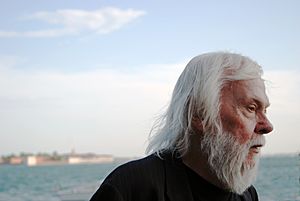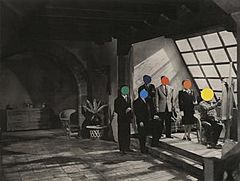John Baldessari facts for kids
Quick facts for kids
John Baldessari
|
|
|---|---|

John Baldessari in 2009
|
|
| Born |
John Anthony Baldessari
June 17, 1931 |
| Died | January 2, 2020 (aged 88) |
| Nationality | American |
| Education | San Diego State University, Otis College of Art and Design, Chouinard Art Institute, University of California at Berkeley |
| Known for | Painting, conceptual art |
|
Notable work
|
Everything is Purged... (1966–68), Tips for Artists Who Want to Sell (1966–68), Bloody Sundae (1987), Frames and Ribbons (1988), Noses & Ears, Etc.: Blood, Fist, And Head (With Nose And Ear) (2006) |
| Style | Contemporary Art |
| Spouse(s) | Carol Ann Wixom (1960–1984) |
| Awards | 2014 National Medal of Arts Award, Golden Lion for Lifetime Achievement, awarded by La Biennale di Venezia, Goslarer Kaiserring |
John Anthony Baldessari (born June 17, 1931 – died January 2, 2020) was a famous American conceptual artist. He was known for his unique artworks that often used photos and images he found. He lived and worked in Santa Monica and Venice, California.
Baldessari started as a painter, but in the mid-1960s, he began adding words and photos to his paintings. By 1970, he was also making prints, films, videos, sculptures, and photography. He created thousands of artworks that showed how images and words could tell stories and create meaning. His art was shown in over 200 solo exhibitions in the U.S. and Europe. Many other artists, like Cindy Sherman and Barbara Kruger, were influenced by his work.
Contents
His Education and Early Life
John Baldessari was born in National City, California. His mother was a Danish nurse, and his father was an Italian salvage dealer. John and his older sister grew up in Southern California. He went to Sweetwater High School and San Diego State College.
He studied at several universities:
- 1949–1953: Earned his Bachelor's degree (B.A.) from San Diego State College.
- 1954–1955: Studied at the University of California, Berkeley.
- 1955: Studied at the University of California, Los Angeles.
- 1955–1957: Earned his Master's degree (M.A.) from San Diego State College.
- 1957–1959: Studied at Otis Art Institute and Chouinard Art Institute in Los Angeles.
Becoming an Artist and Teacher
In 1959, Baldessari started teaching art in San Diego schools. He taught for almost 30 years, from junior colleges to universities. In 1968, he became one of the first teachers in the new Visual Art Department at the University of California, San Diego (UCSD).
In 1970, Baldessari moved to Santa Monica. There, he met many other artists and writers. He also started teaching at CalArts, a famous art school. His students there included artists like David Salle and Mike Kelley. He taught a special "Post Studio class" which encouraged students to think about art beyond just painting or sculpting. This class was very important for how art was taught at CalArts.
He stopped teaching at CalArts in 1986 and moved to UCLA, where he taught until 2008.
Exploring Art: His Main Ideas
Early Text Paintings
By 1966, Baldessari started using photographs and text on his canvases. Some of his first important works were paintings that were mostly empty, except for words painted on them. These words were often ideas about art.
For example, he painted "A TWO-DIMENSIONAL SURFACE WITHOUT ANY ARTICULATION IS A DEAD EXPERIENCE" (1967). He wanted the words to stand out, so he had professional sign painters write them in a simple black font. This made the text feel neutral and direct.
Burning His Old Art
In 1970, Baldessari did something very unusual. He and five friends burned all the paintings he had made between 1953 and 1966. This was part of a new artwork called The Cremation Project. The ashes from these paintings were mixed into cookies and put into a special urn. The art piece also included a bronze plaque with the dates his destroyed paintings were "born" and "died," plus the cookie recipe.
This act showed a connection between making art and the human life cycle. By destroying his old work, he was making way for new ideas.
Mixing Words with Pictures
Baldessari is best known for combining photos, often from movies, and taking them out of their original setting. He would then rearrange them and add words or sentences.
In his Wrong series (1966–1968), he put photos next to text from a photography book. The photos intentionally broke the "rules" of good photography. For instance, he took a picture of himself in front of a palm tree so it looked like the tree was growing out of his head.
Playing Arbitrary Games
Baldessari believed that language and games are similar because they both follow rules that are made up. Many of his artworks showed him trying to reach a random goal.
For example, in Throwing Three Balls in the Air to Get a Straight Line (1973), he tried to throw three balls into the air to form a straight line. He photographed the results and chose the "best out of 36 tries." The number 36 was chosen simply because that's how many photos are on a roll of 35mm film. This work showed how art can come from simple, even silly, experiments.
The Act of Pointing
A lot of Baldessari's work involved "pointing." He would show viewers not only what to look at but also how to choose and compare things, sometimes just for the fun of it.
In his Commissioned Paintings (1969) series, he took photos of a hand pointing at different objects. Then, he hired amateur artists to paint these photos. He added a caption like "A painting by [painter's name]" to each finished painting. This made people think about who really makes the art and what it means to be an artist.
Using Dots in Portraits
From the mid-1980s onwards, Baldessari often covered the faces in his photos and paintings with colorful circular stickers or dots. He once said that he might be remembered as "the guy who puts dots over peoples faces."
These dots look like price stickers you might see at a garage sale. Baldessari said he used them because they "leveled the playing field," making all the faces equal. These "dot portraits" can be paintings, collages, or prints.
Prints and Editions
Baldessari started making prints in the early 1970s. His first print, I Will Not Make Any More Boring Art (1971), was made to raise money for an art college. For an exhibition related to this print, students wrote the phrase "I will not make any more boring art" over and over on the gallery walls.
He worked with many famous print publishers. In the 1990s, he began making three-dimensional prints using special techniques. He also created prints where images were built in layers, sometimes with hand-painting.
Performances and Films
Baldessari also created performances and films. In his 1971 film Police Drawing, he had art students describe him to a police artist, who then drew his portrait. The students had never seen him before.
In the black-and-white video I Am Making Art (1971), Baldessari stands facing the camera for almost 20 minutes. He strikes different poses, like crossing his arms or pointing, and with each new pose, he says, "I am making art." This simple act makes you think about what art really is.
Sculpture Work
Baldessari made his first sculpture in 2007, called Beethoven's Trumpet (with Ear) Opus # 127, 130, 131, 132, 133, 135. It was a giant bronze trumpet coming out of a huge ear on the wall. If you spoke into the trumpet, it would play a short part of a Beethoven song.
He also created other sculptures, like a tall carrot (Fake Carrot, 2016) and a bronze figure stuck in a wooden barrel (Giacometti Variation, 2018).
Major Exhibitions
John Baldessari had a very long career, with over 200 solo shows and 1,000 group shows. His first solo exhibition was in Los Angeles in 1968.
His work has been shown in important art events like:
- Documenta V (1972) and VII (1982)
- the Whitney Biennial (1983)
- the Carnegie International (1985–86)
- the 47th Venice Biennial (1997)
Major museums around the world have also shown his art, including the MOCA in Los Angeles, the Tate Modern in London, and The Metropolitan Museum of Art in New York.
Art in Collections
Baldessari's art can be found in many famous museum collections, such as:
- Art Institute of Chicago
- Museum of Modern Art (MoMA)
- Guggenheim Museum
- Los Angeles County Museum of Art (LACMA)
- Hirshhorn Museum and Sculpture Garden
- Broad Collection
Awards and Recognition
Baldessari received many awards for his art, including:
- 1988: Guggenheim Fellowship
- 1996: Oscar Kokoschka Prize, Austria
- 1997: Governor's Award for Lifetime Achievement in the Visual Arts, California
- 2009: Golden Lion Lifetime Achievement award at the 53rd International Art Exhibition Venice Biennale
- 2012: Goslarer Kaiserring (Kaiser Ring from the City of Goslar), Germany
- 2014: National Medal of Arts Award (one of the highest honors for artists in the U.S.)
In 2013, the California Institute of the Arts opened the John Baldessari Art Studio Building, which provides studio space for art students and teachers.
His Personal Life
John Baldessari was married to Carol Ann Wixom, a teacher, from 1960 to 1984. They had two children.
He lived and worked in Santa Monica and Venice, California, where he had a studio near other famous artists.
See also
 In Spanish: John Baldessari para niños
In Spanish: John Baldessari para niños


